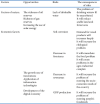Rapid Growth of the World Population and Its Socioeconomic Results
- PMID: 35370481
- PMCID: PMC8967589
- DOI: 10.1155/2022/8110229
Rapid Growth of the World Population and Its Socioeconomic Results
Abstract
This article is mainly devoted to the study of socioeconomic opportunities and problems that may arise from the growth of the world's population. The article identifies the reasons for the increase in world population and analyzes the factors influencing on the process. The article examines the impact of changes on the world's demographics on socioeconomic development. As a result, the characteristics of possible problems were investigated and evaluated. The study analyzes the issues of demographic change in the world population, the current situation, and opportunities of the world economy in accordance with population statistics and its growth rate. The main purpose of the study is to determine the causes of world population growth, analyze the current demographic situation, and determine and assess the forecast of future growth dynamics. The study discusses, analyzes, and evaluates the problems that can be caused by the growth of the world's population. The main problem we raise in the study is the mismatch between the rapid growth of the world's population and the socioeconomic security of the people. That is, if the issue of socioeconomic security is not resolved, the growth of the world's population would be a global social problem.
Copyright © 2022 Rahim Sadigov.
Conflict of interest statement
The authors declare that they have no conflicts of interest regarding the publication of this paper.
Figures





References
-
- United Nations Department of Economic and Social Affairs. Population Division. 2019. https://www.worldometers.info/population/world/
-
- International Programs Center at the U.S. Census Bureau, Population Division . International Programs Center at the U.S.; 2019.
-
- Elwell F. Sociocultural Systems: Principles of Structure and Change . Alberta, Canada: Athabasca University Press; 2013.
-
- Imam P. Demographic shift and the financial sector stability: the case of Japan. Journal of Population Ageing . 2013;6(4):269–303. doi: 10.1007/s12062-013-9089-9. - DOI
-
- World historical and predicted populations. https://p2k.unkris.ac.id/IT/en/3065-2962/seven-billion-people-alive_2265... .
MeSH terms
LinkOut - more resources
Full Text Sources
Research Materials

